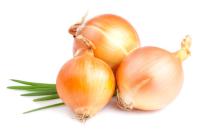Onions
 Onions are similar to garlic but in a more subtle way. There are several different varieties of onions, but the yellow cooking onion is one of the most common. However, red onions, green onions, white onions and chives are also frequently used.
Onions are similar to garlic but in a more subtle way. There are several different varieties of onions, but the yellow cooking onion is one of the most common. However, red onions, green onions, white onions and chives are also frequently used.
Onions can help to lower blood pressure, decrease the risk of cancer, raise beneficial HDL cholesterol, and relieve congestion and reduce inflammation.
Overview
Although onions do not have high concentrations of nutrients, they do have a wide mix of them. They also contain calcium, iron, folic acid, and vitamins A, C and E. Green onions contain more vitamin A and C.
History
This vegetable originated in Central Asia, from Iran to Pakistan and then northward into Russia. Onions have been well thought of since ancient times for their culinary uses and also for their therapeutic properties. As early as the sixth century onions have been used as a medicine in India.
The ancient Greeks and Romans enjoyed onions but typically used extra seasonings with them because they were thought to be too bland by themselves. Poorer people throughout the world made onions popular as means for spicing up meals.
Early explorers brought onions to North America. The leading world producers of onions today are India, China, Spain, the Russian Federation and the United States.
Nutritional Information
Onions are a very good source of vitamin B6 and C, biotin, chromium and dietary fiber. They are also good sources of vitamins B1 and E and folic acid. A 100-gram serving has 44 calories, mostly in carbohydrates, and provides 1.4 grams of fiber.
Health Benefits
Onions contain quite a variety of organic sulfur compounds that promote good health. Onions, like garlic, contain the enzyme alliinase, a substance that is released when an onion is crushed or cut, causing the conversion of trans-S- (l-propenyl) cystein sulfoxide to the lacrimatory, propanethial S-oxide. Other nutrients in onions include flavonoids (primarily quercetin); phenolic acids, such as ellagic, caffeic, sinapic, and p-courmaric; sterols; saponins; pectin; and volatile oils.
While this vegetable has not been as acclaimed as garlic in its medicinal or health-giving uses, the onion is still widely used. Onions have many of the same positive qualities as garlic, but there are subtle differences which make one of the vegetables more beneficial than the other when used for certain conditions.
Clinical research has shown onions and onion extracts decrease blood lipid levels, prevent clot formation and lower blood pressure. Onions have also been proven to have a significant action on lowering blood sugar, comparable to that of the prescription drugs phenformin and tolbutamide, which are often prescribed for patients with diabetes.
The active blood sugar lowering component in onions is thought to be allyl propyl disulfide (APDS), although other constituents (such as flavonoids) may play a part as well. Clinical and experimental evidence suggests that APDS helps to lower glucose levels by competing with insulin (also a disulfide molecule) for breakdown sites in the liver. This increases the life span of the insulin.
Historically speaking, onion has also been used to treat asthma. Its positive effect on asthma sufferers is due to its ability to inhibit the production of substances that cause the bronchial muscle to spasm and to relax the bronchial muscle.
Last but definitely not least is the onion's potential for cancer protection. Onions may be a key player in preventing cancer, especially cancers involving the gastrointestinal tract. Studies have shown that quercetin, the primary flavonoid found in onions, actually halts the progression of tumors in the colons of animals. This suggests that onions combat cancer in two ways, as the sulfur compounds also fight cancer.
Several of the sulfur-containing compounds of onions are responsible for tear production when an onion is cut. The compound allyl sulfate, which is produced when sulfur compounds released by the onion's ruptured cells are exposed to air, is particularly irritating. In order to minimize the production of this compound onions can be chilled for an hour or two before they are cut. Chilling helps to reduce the activity of the enzyme that produces the allyl sulfate.
Use a very sharp knife when cutting onions and stand so your eyes are as far away from the newly-cut onion as possible.
Safety
Onions contain small amounts of oxalates. Those people who have a history of oxalate-containing kidney stones should avoid or limit their consumption of onions.
Selecting and Storing
Although onions can be eaten on their own, they can also be served in the following ways:
- Sauteed and added to almost any vegetable dish.
- Used in a vegetarian chili made by heating together 1 medium chopped, sauteed onion with a 12-ounce can of kidney beans, 12 ounces of chunky tomato sauce, 2 tablespoons of olive oil, and seasoning to taste with chili powder.
- Made into a guacamole-salsa dip by combining 1 chopped red onion, 2 Roma tomatoes, 2 avocados, and 1 jalapeno.
- Skewered pearl onions, alone or with other vegetables and coated lightly with olive oil. Grill for 10 minutes.
References
- Holford, P.(2004). The optimum nutrition bible. London : Piatkus
- Holford, P & Lawson, S. (2008). Optimum Nutrition Made Easy How to achieve optimum health. London : Piatkus
- Murray, M.T. et al.(2005). Encyclopedia of healing foods. London : Piatkus
- Yeager, S. & Prevention Health Books. (1998). The doctors book of food remedies : the newest discoveries in the power of food to cure and prevent health problems from aging and diabetes to ulcers and yeast infections. [Emmaus, Pa.] : Rodale
Posted in Onions
Ask a Question Or Join a Discussion


